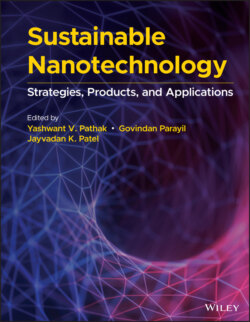Читать книгу Sustainable Nanotechnology - Группа авторов - Страница 31
1.4.1 Water Purification
ОглавлениеClean water is an essential part of global sustainability. The constantly increasing the global human population increases the demand for clean water; however, population increase is also a factor in the growth of industries, a huge factor in the decrease in water quality. Making clean and affordable water accessible to people is still a challenge today [96]. There are various conventional methods used today for water treatment and purification. Nanomaterial‐based water purification methods, however, not only improve the quality of water but also extend purification treatments to remote areas without electricity [97]. Many nanomaterials used in nano oncology and for drug delivery are also utilized in water treatments. For example, CNTs, in this case acting as nano adsorbents, are better alternatives of activated carbon because they are able to absorb organic chemicals more efficiently than activated carbon [98].
Nanomembranes are another method of removing microparticles from water. These membranes are composed of nanofibers and, when combined with metal oxide nanoparticles, can intensify membrane surface hydrophilicity, water permeability, and fouling resistance [96]. Nanocatalysts, such as zero‐valent metal, semiconductor materials, and bimetallic nanoparticles, are used in purification treatment to amplify reactivity and degradation of contaminants such as pesticides and herbicides [99]. Studies show that silver nanocatalysts, N‐doped TiO₂, and ZrO₂ nanoparticles are successful in the degradation of contaminants in water [100]. Similar to nanocatalysts, nanostructured catalytic membranes also have higher rates of decomposition and selectivity. These membranes require less contact time, can be scaled for commercial purposes, are composed of homogeneous catalytic sites, and allow multiple reactions to take place simultaneously [101].
